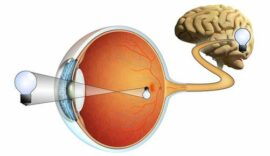Posted by:
Eyes on Rosemont
in A Child's Vision
Symptoms and Problems Caused By Autism Autism is a neurological disorder in which the person has difficulty processing and reacting to information received from their senses. The individual also has trouble communicating and interacting socially. Signs of autism include: Lack of shared social interaction Postponement in development Untimely response to sensory information As a result […]
Read
More
Posted by:
Eyes on Rosemont
in A Child's Vision
Crossed eyes, also known as strabismus, refer to a condition in which both eyes do not look at the same place at the same time. Often times they both turn in, but may also turn out. What Causes Crossed Eyes? The six muscles attached to each eye, which control how it moves, receive signals from […]
Read
More
Posted by:
Eyes on Rosemont
in A Child's Vision
Dyslexia When a child has difficulty reading due to problems recognizing speech sounds and learning how they connect to words and letters, the condition is known as dyslexia, a learning disorder caused by genetic traits that disturb how the brain works. It affects areas of the brain dealing with language and inhibits one’s ability to […]
Read
More
Posted by:
Eyes on Rosemont
in All About Eyes, Protecting Your Eyes
Eating right is essential for keeping your body healthy. This is as true for your eyes as it is for your heart. A diet that is rich in fresh fruits, vegetables and whole grains, and is low in saturated fat, can reduce your risk of heart disease. This will also keep your arteries healthy, so […]
Read
More
Posted by:
Eyes on Rosemont
in All About Eyes, Protecting Your Eyes
We take a lot of aspects of our vision for granted. We expect to see nearby and faraway objects clearly, even if we require our eye care provider to prescribe eyeglasses or contact lenses to do so. A huge degree of the information we take in about our world and our surroundings takes place visually, […]
Read
More
Posted by:
Eyes on Rosemont
in Basic Visual Skills, How the Eyes Work
Eye movement refers to the voluntary and involuntary movements of the eyes that assist with obtaining, fixating and following visual stimuli. The eyes are each connected to a system of six muscles. Light is sensed by the retina, which is a type of tissue that contains cells known as photoreceptors. These cells translate light into […]
Read
More
Posted by:
Eyes on Rosemont
in A Child's Vision
Lazy eye, also referred to as amblyopia, is a condition that develops in infancy or early childhood, and it typically starts when the focus in one eye is more enhanced than the other. The eye with less focus might be impaired due to a significant amount of farsightedness or astigmatism, or something could be obstructing […]
Read
More
Posted by:
Eyes on Rosemont
in A Child's Vision, Protecting Your Eyes
Did you know that your eyes are an extension of your brain? There are six muscles connected to each eye, and they receive signals from the brain. These signals direct the eyes movements and, thus, control their ability to focus. When you are stressed, your brain goes through a number of changes and signals some […]
Read
More
Posted by:
Eyes on Rosemont
in All About Eyes
Of our five senses, humans rely on vision most strongly. Our everyday experience of the world is colored by our ability to see, our memory draws heavily upon visual information, and many activities of daily living are challenging without sight. As a result, it is essential to protect your eyes from damage. Regular visits to […]
Read
More
Posted by:
Eyes on Rosemont
in A Child's Vision
For many adults, reading and writing come so naturally that they seem almost effortless. However, reading and writing are actually complicated skills that take significant effort to learn. For example, reading involves recognizing letters, associating letter combinations with their corresponding sounds, blending sounds together, identifying words, and connecting words to their meanings. Vision problems can […]
Read
More










